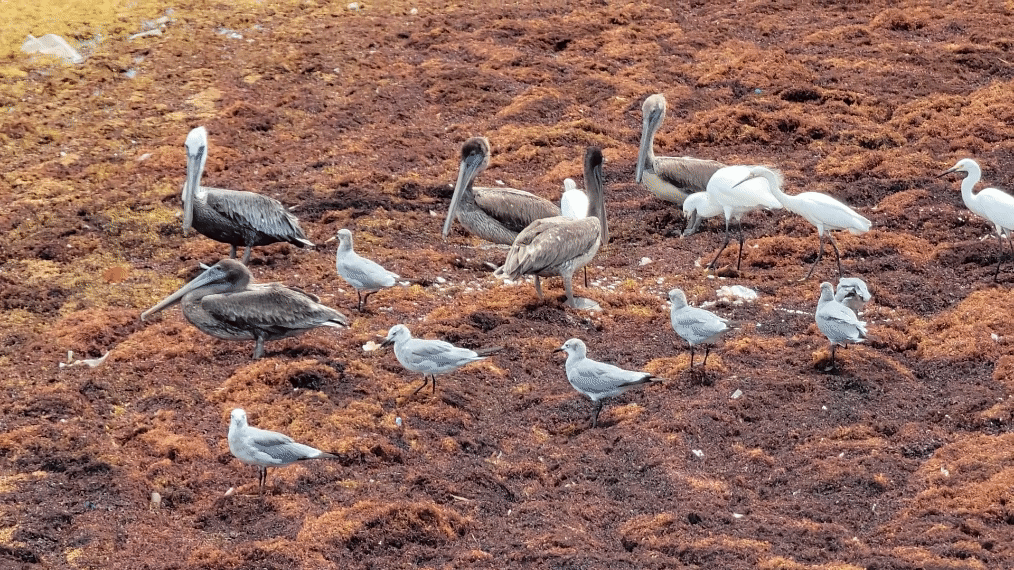For more than 20 years, Mexican biologist María del Carmen García Rivas has led a crusade to protect the coral lining the Yucatan Peninsula in the Caribbean Sea. As director of the Puerto Morelos Reefs National Park in México, she has advocated for reforms to reduce runoff and other pollution from coastal development.
She has spearheaded efforts to control lionfish, an exotic invasive species that has put at risk the nearly 670 species of marine fauna that inhabit the park. And since 2018, she has organized brigades to restore reefs damaged by tissue-destroying coral diseases known as white syndromes. But now, yet another threat has been keeping her awake at night: massive blooms of sargassum seaweed reaching the coast of the park.
“When the sargassum, a macroalgae that usually floats, reaches the coasts, it begins to decompose, generating an environment without oxygen that kills different organisms,” she said. “It mainly affects species that cannot move or move very little, such as some starfish, sea urchins, the sea grasses themselves, and of course corals.”
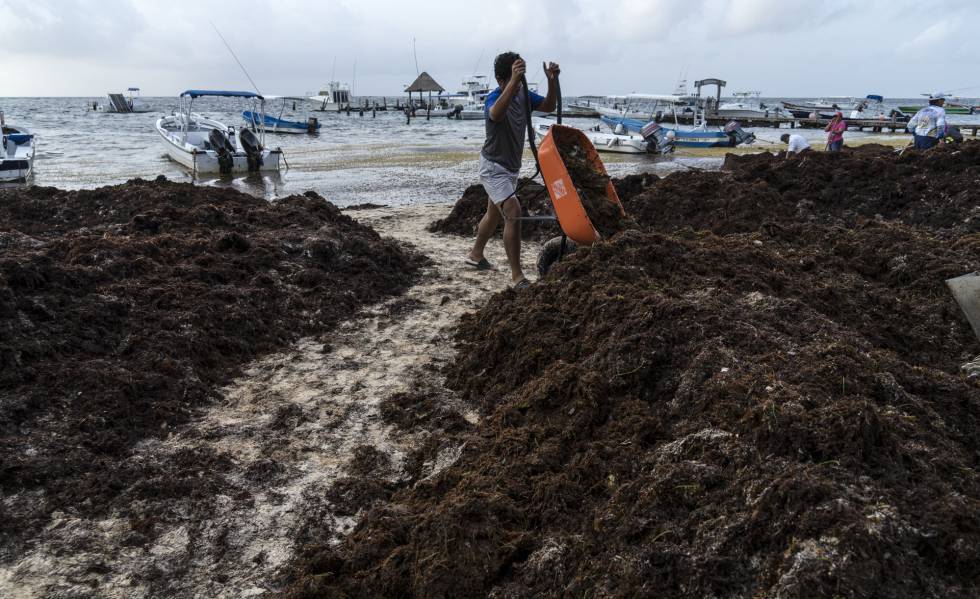
People picking up excess sargassum from the Mexican coast in the Mayan Peninsula .
Photo by Gladys Serrano | El País
Along the coast of Quintana Roo, the Mexican state where the Puerto Morelos Reefs National Park is based, the local government collected 70 tons of sargassum during 2023 alone, said Huguette Hernández Gómez, the state’s Secretary of Ecology and Environment. Added to what they collected during the last four years, the figure reaches 200 tons.
Regional problem
This story is familiar across the Caribbean. Though modest amounts of sargassum benefit marine life in the region, massive influxes arriving since 2011 have upset the ecological balance in some areas in ways that could be irreversible.
The seaweed has exacerbated existing stress on the region’s reefs, which last year faced a massive bleaching event linked also to warming waters associated with climate change. Exposure to extreme temperatures for extended periods breaks down the relationship between the corals and the algae living inside of them. Corals are left pale or white, and the lack of food from algae can lead them to die, according to the United States National Oceanic and Atmospheric Administration (NOAA).
Sargassum mats have also blocked sea turtle nesting sites and inundated mangroves, which serve as crucial nurseries for countless aquatic species.
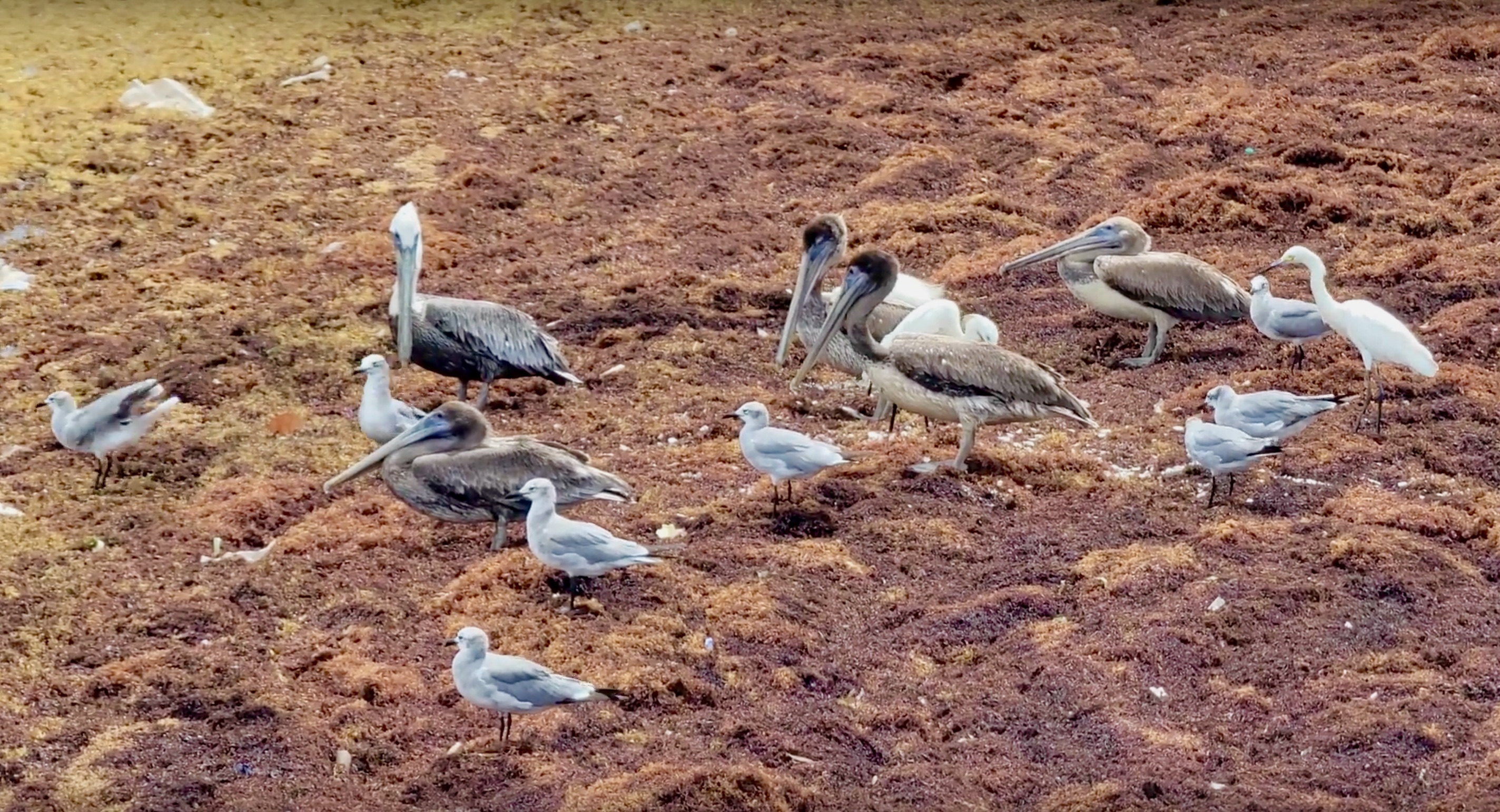
Birds feed on small fish caught in seaweed mat along the South-Eastern coast of the Portmore Causeway in St. Catherine, Jamaica on May 2, 2023.
Photo by Kirk Wright | Television Jamaica
In some areas, beaches have been eroded by the seaweed and by the heavy machinery used to remove it. Many fishers complain that their catch has dwindled sharply.
But because of the magnitude of the relatively recent problem — which is affecting coastlines from West Africa to the Americas — the true extent of the environmental damage is poorly understood, according to Dr. Brian LaPointe, a biologist and sargassum expert at Florida Atlantic University.
“We haven’t gotten very far in the research to understand the causes or how to deal with it and manage and mitigate the impacts on the environment,” LaPointe said.
Second largest barrier reef
The effects that García Rivas has seen in Mexico illustrate the implications for the entire region. The park she oversees is part of the Mesoamerican Barrier Reef System, which stretches along more than 600 miles of coastline in Mexico, Belize, Guatemala and Honduras.
As the second longest barrier reef in the world — only the Great Barrier Reef in Australia is longer, at about 1,400 miles — the Mesoamerican Barrier Reef is home to some 500 species of fish and 60 species of stony corals, according to the World Wildlife Fund (WWF). It also supports the livelihoods of one to two million people in the region, the WWF states.
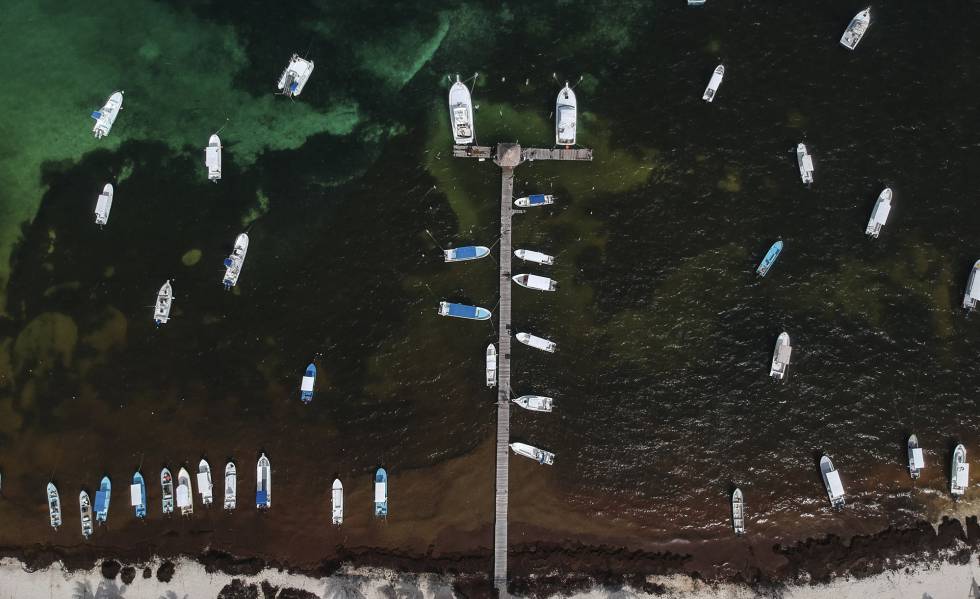
Sargassum invades the sea of the Mexican coast of the Mayan Peninsula.
Photo by Gladys Serrano | El País
Floating sargassum can provide a healthy habitat, but when it washes against the shore in mass quantities it often suffocates certain organisms, said James Foley, Director of Oceans for The Nature Conservancy.
“In coastal areas like Belize, the problem is further exacerbated by the fact that the sargassum also attracts a lot of marine rubbish: local garbage that runs off from the rivers that come into the Caribbean from Central America. So it ends up being a pretty toxic environment,” he said.
The sargassum also creates a barrier that blocks light and prevents organisms below it from photosynthesizing, according to Foley.
A 2021 study published in the scientific journal Climate Change Ecology, which analyzed the situation in three bays in Quintana Roo, Mexico, found that under the sargassum mats the light seepage decreased up to 73% and the water temperature could be as much as 5 degrees Celsius warmer.
Bacterial diseases
In addition, García Rivas said, bacteria carried by the sargassum may be affecting the corals as well.
“Some of the diseases suffered by the corals could be related to all the bacteria brought in by the sargassum or that arise during its decomposition,” she said. “Although it becomes an environment without oxygen, there are bacteria that may be able to survive, affecting not only the corals but also generating fish mortality.”
Such effects exacerbate existing threats to the reef, she said, noting that the worst historical damage has come from coastal development and inadequate management of sewage and other waste.
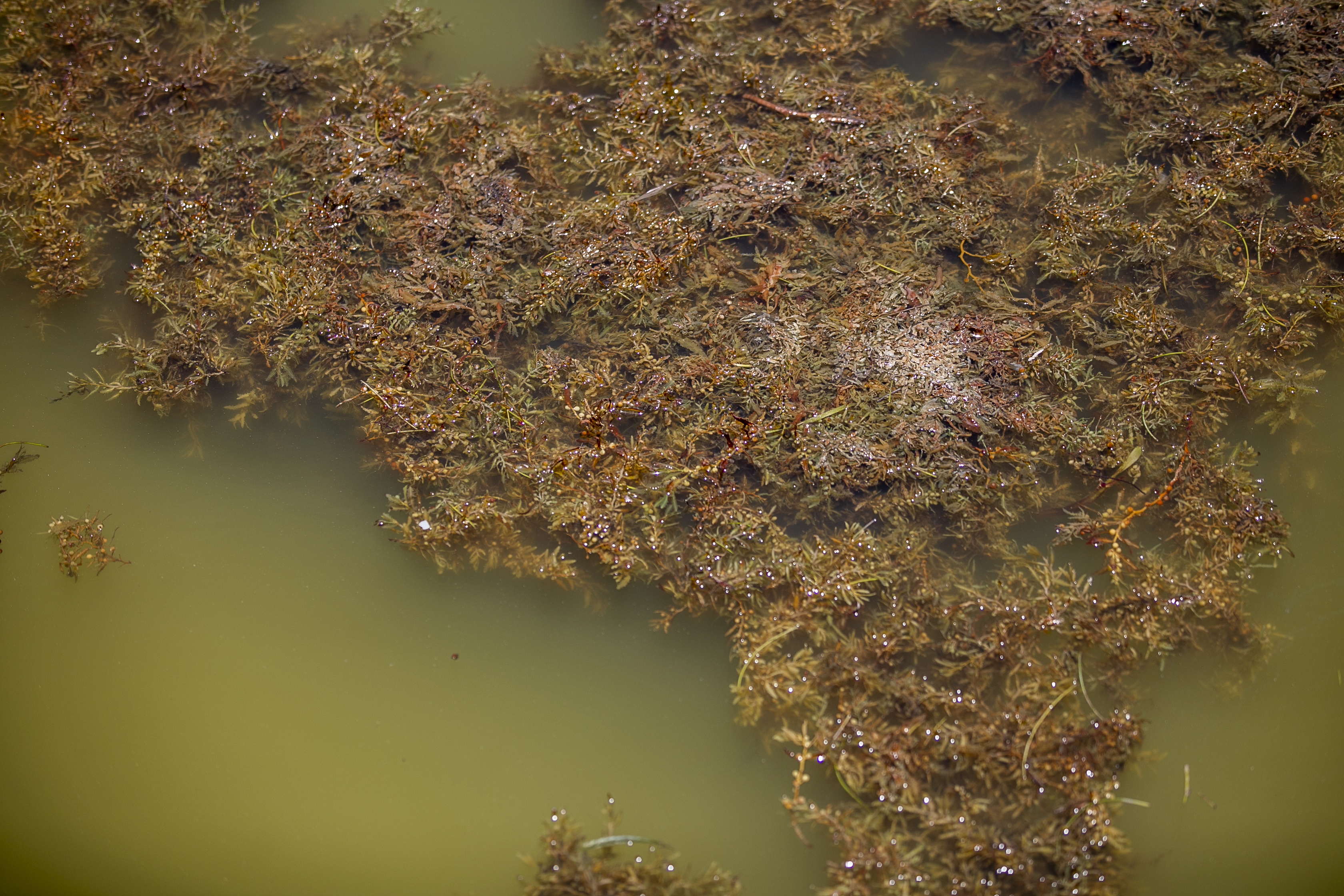
Sargassum at the Palmas del Mar marina in the municipality of Humacao in Puerto Rico, where it has arrived massively.
Photo by Xavier García | Centro de Periodismo Investigativo
“In general, contaminated seawater does not allow corals to live properly,” she said. “It weakens them. And when they present diseases or are stressed by heat, it is easier for them to die.”
A similar scenario has played out in Jamaica, according to Dr. Camilo Trench, a marine biologist at the University of the West Indies (UWI) in Jamaica.
“The problem is that the seaweed grows fast and the corals grow slowly,” Trench said. “So if the sargassum is in the area with other macroalgae, it can overgrow the coral reef area quite quickly. So now it will not only reduce the space that the corals will have to grow: It will also reduce the settlement area of the coral nursery.”
Sargassum smothers other species too
Coral might be one of the most visible animals affected by sargassum, but is not the only one. A study published in the Marine Pollution Bulletin analyzed a massive sargassum influx that swamped the shores of the Mexican Caribbean in 2018, decomposing and turning the water cloudy. As a result, the researchers found, organisms from 78 wildlife species died. The worst affected were demersal neritic fish, which live at the bottom of shallow areas of the sea, and crustaceans.
Other scientists have raised concerns about sargassum’s effects on turtle nests. In 2017, Briggite Gavio, a professor of marine biology at the National University of Colombia, visited Cayo Serranilla, a tiny 600-by-400-meter island at the northernmost tip of the Colombian Caribbean. The island is only inhabited by military personnel and it’s a perfect place for sea turtles to nest.
But when Gavio was there as part of a scientific expedition, sargassum had formed a mat up to 40 centimeters high on the beaches. “We were able to observe that some turtle hatchlings had trouble getting past the barrier posed by the sargassum mat, and were vulnerable to predation by ghost crabs, rats and other predators,” she wrote in a 2018 paper about her observations.
Similar observations about the effects of sargassum in sea turtles have been made by scientists on other islands such as Antigua and Barbuda.
Killing mangroves too
Sargassum also appears to have a potentially lethal impact on Caribbean mangroves, an important natural barrier for extreme hurricanes.
“These are plants that live on the seashore and are tidal plants, but they depend on their aerial roots and their respiratory roots, which are underground, for oxygen,” said Trench, the biologist in Jamaica. “Now imagine a mat covering those roots and preventing oxygen from flowing through them. It can definitely cause death if it is long-term and similar to the impact of something like oil slicks on the mangrove or litter, such as solid waste.”
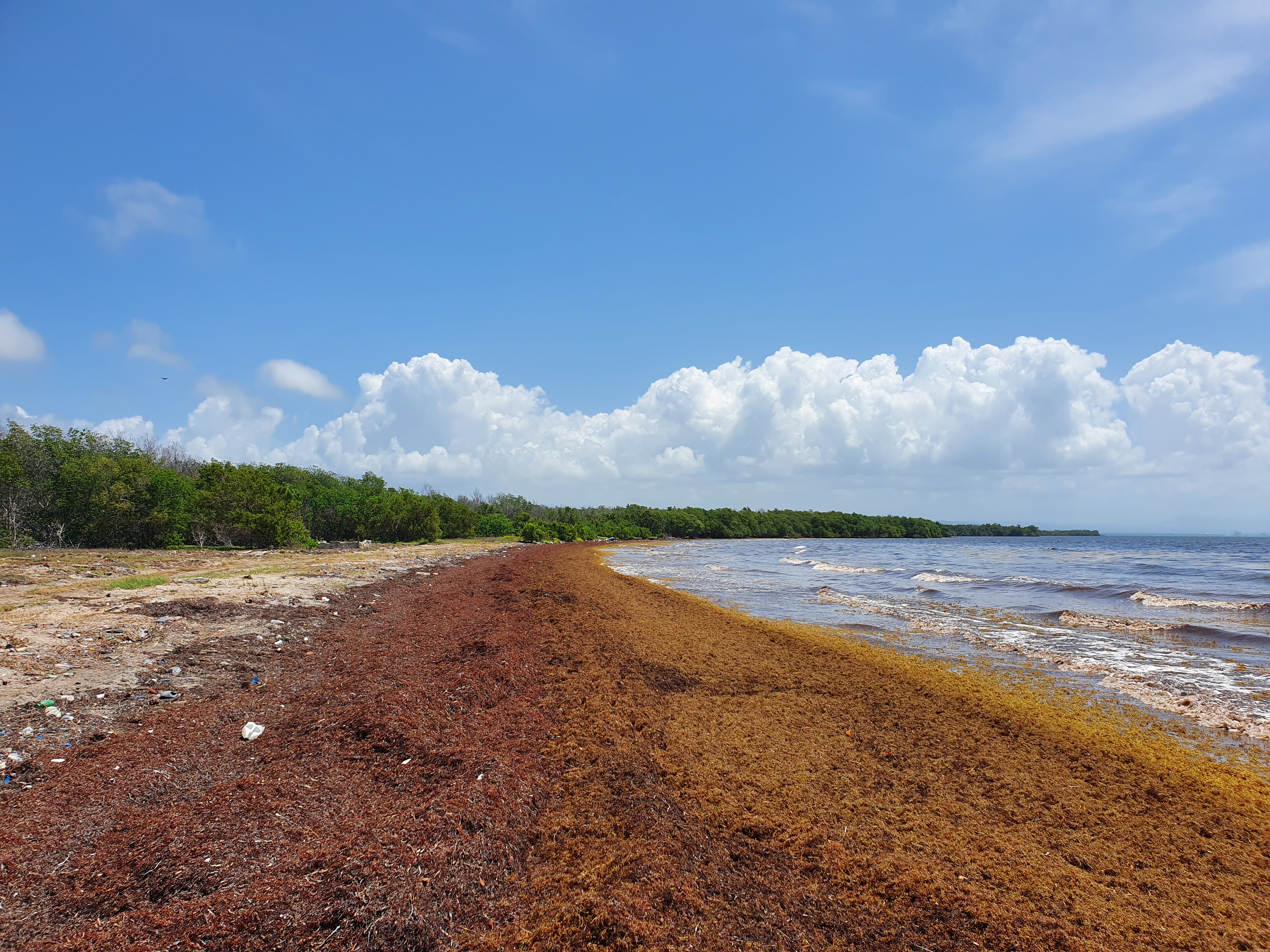
Sargassum has impacted areas of Jamaica where mangrove forests are located, such as in Salt River.
Photo by Kirk Wright | Television Jamaica
As with corals, mangroves sometimes end up smothered, sustaining damage themselves and putting at risk other species that depend on them.
No ‘virtuous circle’
For García Rivas, the biologist in Mexico, one fact is particularly alarming: Unlike many other problems facing the reefs she oversees, the sargassum influx has no clear solution.
“We haven’t come up with a virtuous circle as we have, for example, with lionfish,” she said. “Despite being an invasive species, [lionfish] can be fished and eaten, which mitigates the problem.”
Local government looks for solutions
Faced with this problem, last year the state of Quintana Roo created a committee of 60 experts from different areas that worked for seven months to help create what is now known as the Integral Strategy for the Management and Use of Sargassum in Quintana Roo.
The strategy covers eight areas: health; research and monitoring; knowledge management, processes and logistics; utilization; legal framework; economic instruments and cross-cutting axes. Its key advances include designating the state of Quintana Roo as the authority in charge of granting permits to researchers and companies working to turn sargassum into a product.
“The state government is the one that gives all the permits for issues ranging from transportation, collection to final destination. With that we avoid that companies are going around in circles between whether to ask the federal or municipal government where to acquire the permits,” said Hernández Gómez, the ecology and environment secretary.
The response is costly. Last year, she said, the Secretariat of the Navy was assigned about $3 million to collect sargassum at sea using its ships and anchorage barriers, while the Federal Maritime Terrestrial Zone was assigned about $7 million more to collect it from beaches. In Quintana Roo, through the Secretariat headed by Hernandez Gómez, another $1.7 million is coming in to address the problem.
“And this year that investment will be maintained,” she said.



